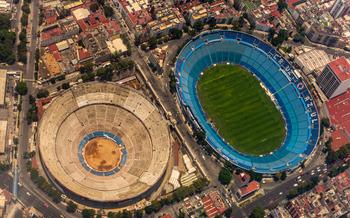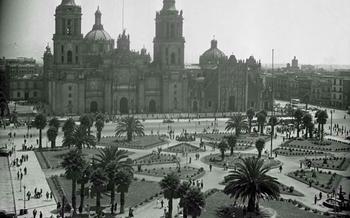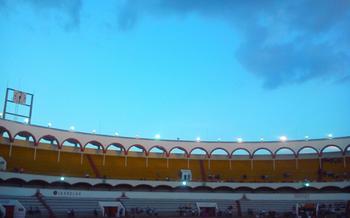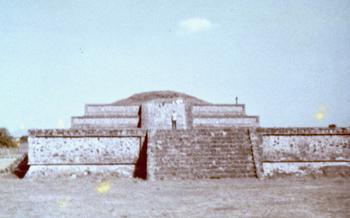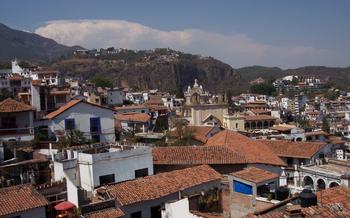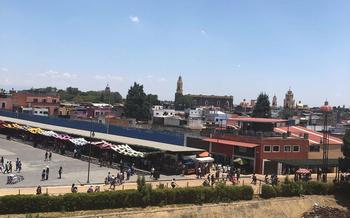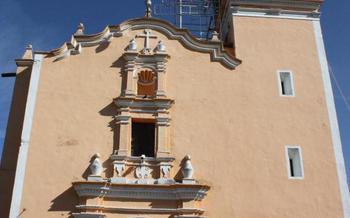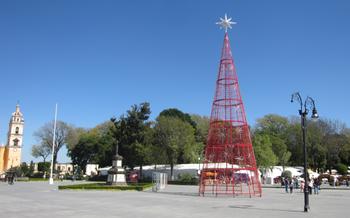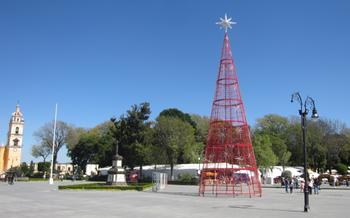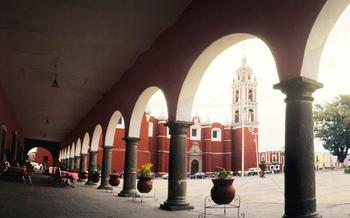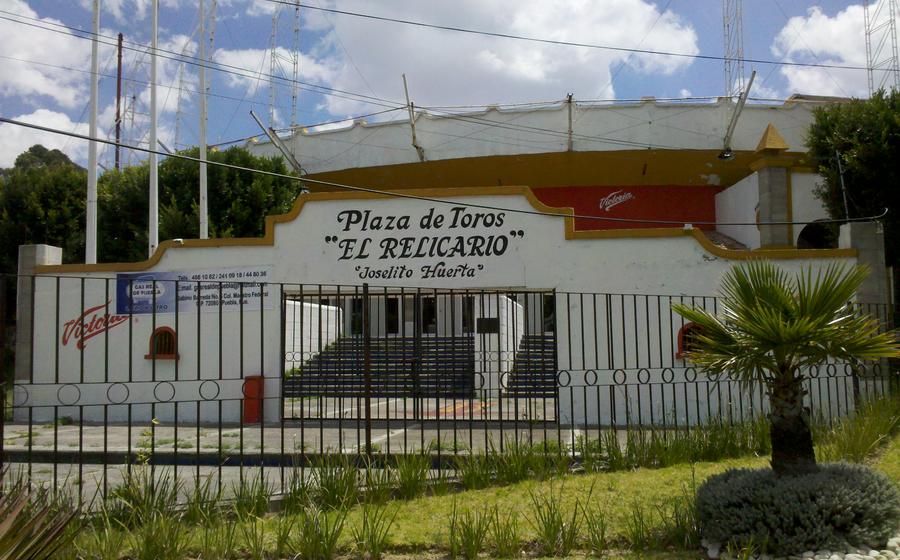
Plaza de Toros El Relicario
- The Plaza de Toros El Relicario: A Historical Landmark
- Location and Accessibility
- Events and Performances
- Guided Tours
- The Bullfighting Tradition in Mexico
- Bullfighting Museum
- Plaza de Toros El Relicario as a Cultural Venue
- Exploring the Neighborhood
- History of Bullfighting in Puebla
- Photography and Videography
- Souvenirs and Merchandise
- Safety and Security
- Planning Your Visit
- Insider Tip: Experience the Local Flavor
The Plaza de Toros El Relicario: A Historical Landmark
Situated in the heart of Puebla, Mexico, the Plaza de Toros El Relicario stands as a testament to the city's rich history and cultural heritage. Constructed in the late 19th century, this iconic bullring is considered one of the most significant landmarks in Mexico and is renowned for its architectural beauty and historical significance.
The plaza was meticulously designed by renowned Mexican architect Antonio Rivas Mercado, who also crafted the famed Palacio de Bellas Artes in Mexico City. Inspired by Moorish and Byzantine architectural styles, El Relicario showcases a unique blend of intricate arches, colorful tiles, and ornate detailing. Its eight towers and domed roof create a striking silhouette against the city skyline, making it an unmissable attraction for visitors and locals alike.
Beyond its architectural splendor, El Relicario holds immense cultural significance. Bullfighting has been an integral part of Mexican culture for centuries, and the plaza has played a pivotal role in preserving and showcasing this tradition. Throughout its history, El Relicario has hosted countless bullfights, attracting both domestic and international aficionados of the sport.
Location and Accessibility
The Plaza de Toros El Relicario is conveniently situated in the heart of the historic center of Puebla, Mexico, at Avenida Reforma 1011, Colonia Centro. Its central location makes it easily accessible by foot, public transportation, or taxi.
For those arriving by car, there is limited street parking available in the surrounding area. However, it's worth noting that the streets can be narrow and congested, especially during event days. Therefore, it's advisable to plan accordingly and arrive early to secure a parking spot. Alternatively, you can opt for nearby paid parking lots or garages to ensure a hassle-free experience.
Events and Performances
The Plaza de Toros El Relicario hosts a variety of events and performances throughout the year, including bullfights, concerts, and cultural shows. Bullfights are the main attraction, taking place every Sunday from October to March. The season typically runs from October to March, with fights held every Sunday at 4 pm. Tickets can be purchased at the box office or online, and prices vary depending on the seat location.
In addition to bullfights, the plaza also hosts occasional concerts, live performances, and cultural events. These events can range from traditional Mexican music concerts to art exhibitions and festivals. Special events and festivals, such as the annual Feria de Puebla, often feature bullfights and other cultural performances.
Guided Tours
For those who want a more in-depth understanding of the Plaza de Toros El Relicario and its history, guided tours are available. Knowledgeable guides will take you behind the scenes of the bullring, providing insights into its construction, architecture, and cultural significance. You'll learn about the different types of bullfights held here, the famous bullfighters who have graced its arena, and the controversies surrounding the sport.
Duration and Cost
Guided tours typically last for about an hour and cost around $10-$15 per person. They are offered in Spanish and English, and reservations can be made in advance or on the day of your visit.
What to Expect from a Tour
During your tour, you'll visit the various areas of the bullring, including the bull pens, the matador's dressing room, and the presidential box. You'll learn about the different stages of a bullfight and the roles of the various participants. You'll also have the opportunity to see historical artifacts and memorabilia related to bullfighting in Mexico.
The Bullfighting Tradition in Mexico
Bullfighting in Mexico is a deeply rooted tradition that dates back to the 16th century when it was introduced by the Spanish conquistadors. Over the centuries, it has evolved into a unique and significant cultural expression that holds a special place in Mexican society. Bullfighting in Mexico is not merely a sport but a complex spectacle that combines elements of art, tradition, and ritual.
There are two main types of bullfights in Mexico: the corrida de toros and the corrida de rejones. In the corrida de toros, a matador (bullfighter) on foot faces a bull in a one-on-one duel, using a red cape and a sword to weaken and eventually kill the bull. In the corrida de rejones, the matador is mounted on a horse and uses lances to subdue the bull.
Bullfighting in Mexico has been a subject of controversy and debate, particularly in recent years, due to concerns about animal welfare. Animal rights activists have condemned the practice, arguing that it is cruel and unnecessary. However, bullfighting proponents maintain that it is a cultural tradition that should be preserved and that the bulls are treated humanely.
Bullfighting Museum
The Bullfighting Museum, housed within the Plaza de Toros El Relicario, is a fascinating repository of artifacts and exhibits that delve into the history, traditions, and cultural significance of bullfighting in Mexico. The museum's collection includes an array of historical bullfighting posters, photographs, and paintings, offering a glimpse into the evolution of the sport over the centuries. Visitors can also admire a collection of ornate matador costumes, each adorned with intricate embroidery and shimmering sequins, showcasing the artistry and craftsmanship that goes into these traditional garments.
Interactive displays provide an immersive experience, allowing visitors to learn about the techniques and strategies used by matadors in the ring. They can also test their skills with a virtual bullfighting simulator, offering a unique and engaging way to understand the challenges and complexities of the sport. The museum also features a section dedicated to the history of the Plaza de Toros El Relicario itself, showcasing its architectural features, significant events, and the role it has played in the cultural landscape of Puebla.
Plaza de Toros El Relicario as a Cultural Venue
Beyond bullfights, the Plaza de Toros El Relicario has evolved into a versatile cultural venue that hosts a diverse range of events and performances. The plaza's unique atmosphere and historical significance make it an ideal setting for concerts, live performances, art exhibitions, and other cultural events.
Concerts and live performances: The plaza's spacious arena and excellent acoustics make it a popular venue for concerts and live performances. Renowned Mexican and international artists have graced the stage of the Plaza de Toros El Relicario, offering unforgettable performances to music enthusiasts.
Art exhibitions and cultural events: The plaza's versatile spaces also serve as venues for art exhibitions and cultural events. Local and international artists showcase their works in temporary exhibitions, transforming the bullring into a vibrant art gallery. Cultural festivals and events, such as dance performances, theater productions, and traditional Mexican celebrations, also find a home within the plaza's walls.
Weddings and special occasions: The Plaza de Toros El Relicario's unique charm and historical significance make it a sought-after venue for special events such as weddings, anniversaries, and corporate functions. The plaza's elegant ambiance and versatile spaces provide a memorable setting for these celebrations, creating a truly unique and unforgettable experience.
Exploring the Neighborhood
Beyond the Plaza de Toros El Relicario, the surrounding neighborhood offers a vibrant cultural experience. Take a leisurely stroll to discover nearby attractions like the majestic Biblioteca Palafoxiana, home to an impressive collection of rare books and manuscripts. Admire the intricate Talavera tiles adorning the Museo del Talavera, showcasing the city's renowned ceramic art. For a glimpse into the region's history, visit the Museo Amparo, which houses pre-Hispanic artifacts and colonial-era paintings.
Indulge in the culinary delights of Puebla at the nearby Mercado El Parián, a bustling marketplace filled with aromatic food stalls. Sample traditional dishes like mole poblano and chiles en nogada, or savor fresh produce, spices, and handcrafted souvenirs.
After a day of exploration, unwind at one of the charming cafes or restaurants lining the cobblestone streets. Sip on a refreshing agua fresca or indulge in a cup of freshly brewed coffee while soaking in the lively atmosphere. As night falls, the neighborhood transforms into a vibrant hub of activity, with bars and nightclubs offering live music, dancing, and a chance to experience Puebla's vibrant nightlife.
History of Bullfighting in Puebla
Bullfighting has a rich and extensive history in the state of Puebla, Mexico. It was introduced to the region during the colonial period, and quickly gained popularity among the local population. Over the years, bullfighting became an integral part of Puebla's cultural traditions, and it is still widely practiced today.
The city of Puebla is home to several historic bullrings, including the Plaza de Toros El Relicario. This iconic venue has played a pivotal role in the development of bullfighting in the region. Many legendary bullfighters have graced its ring, including Rodolfo Gaona and El Cordobés.
Puebla is also known for its unique style of bullfighting, which incorporates elements from both Spanish and Mexican traditions. This distinctive approach has earned Puebla a reputation as one of the leading centers of bullfighting in Mexico.
Famous bullfighters from Puebla include Lorenzo Garza, who was known for his daring and innovative style, and Eloy Cavazos, who is considered to be one of the greatest bullfighters of all time.
Local bullfighting traditions in Puebla include the "corrida de toros," which is a traditional bullfight featuring three matadors each fighting two bulls, and the "rejoneo," which is a form of bullfighting on horseback.
Photography and Videography
The Plaza de Toros El Relicario offers a unique and immersive experience that visitors may want to capture through photography and videography. Here are some guidelines and tips to help you get the best shots:
-
Respect the Privacy of Others: While taking photos and videos, be mindful of the privacy of other attendees. Avoid capturing people's faces or personal moments without their consent.
-
Follow the Rules: The plaza may have specific rules and regulations regarding photography and videography. Be sure to follow these rules to avoid any issues or disruptions during the event.
-
Use Appropriate Equipment: Bring a camera or smartphone with a good zoom lens to capture close-up shots of the bullfight. A tripod can also be helpful for stabilizing your shots and preventing blur.
-
Capture the Action: Focus on capturing the dynamic moments of the bullfight, such as the matador's passes, the bull's charges, and the crowd's reactions.
-
Experiment with Different Angles: Move around the plaza to find different vantage points and angles that offer unique perspectives of the bullfight.
-
Share Your Experience: Once you have captured your photos and videos, share them with friends and family or post them on social media to share your experience with others.
Souvenirs and Merchandise
As you explore the Plaza de Toros El Relicario, you'll find a variety of shops and stalls selling bullfighting-related souvenirs and merchandise. These items make for unique and memorable gifts to commemorate your visit to this historic landmark.
The most popular souvenirs include miniature bullfighting figurines, posters featuring famous bullfighters, and traditional Mexican bullfighting attire such as trajes de luces (suits of lights) and monteras (hats). You can also find a selection of books, DVDs, and other memorabilia related to the history and culture of bullfighting in Mexico.
If you're looking for something truly special, consider purchasing a piece of bullfighting art. Local artisans often create paintings, sculptures, and other works of art inspired by the bullfighting tradition. These pieces make for stunning additions to any home or office and serve as a reminder of your time in Puebla.
When shopping for souvenirs, be sure to bargain with the vendors to get the best prices. You can also find a wider variety of souvenirs at the nearby Mercado El Parián, which is a traditional Mexican market known for its handicrafts and souvenirs.
Safety and Security
The Plaza de Toros El Relicario is generally a safe place to visit, but as with any large public event, it's essential to be aware of your surroundings and take precautions to protect your belongings. Here are some safety tips to keep in mind:
-
Be aware of your surroundings: Avoid distractions and pay attention to people around you. Keep your valuables close and don't leave them unattended.
-
Follow the security guidelines: The plaza has security measures in place, such as metal detectors and bag checks. Cooperate with the security personnel and follow their instructions.
-
Be cautious with your belongings: Keep your bags and pockets zipped and avoid carrying large amounts of cash. Consider using a money belt or other security device to keep your valuables safe.
-
Stay hydrated: Bullfights can be long and hot, so drink plenty of water to stay hydrated.
-
Be respectful of the local culture: Bullfighting is a deeply rooted tradition in Mexico, and it's essential to be respectful of the local customs and traditions. Avoid making disparaging remarks or engaging in disruptive behavior.
-
In case of an emergency: If you see or experience anything suspicious or feel unsafe, immediately notify the nearest security personnel. They are trained to handle emergencies and will assist you accordingly.
Planning Your Visit
When planning your visit to the Plaza de Toros El Relicario, consider the following tips:
-
Best Time to Visit: Although the Plaza is open year-round, the best time to visit is during the dry season (November to April) when the weather is pleasant.
-
Budgeting and Saving: Bullfight tickets can vary in price depending on the event and seating category. Look for discounts and promotions offered by the plaza or tour operators. Pack your own snacks and drinks to save on expenses.
-
Packing Essentials: Wear comfortable clothing and shoes as you'll be doing a lot of walking. Bring a hat, sunglasses, and sunscreen to protect yourself from the sun. Don't forget your camera to capture your memories.
Insider Tip: Experience the Local Flavor
To fully immerse yourself in the local culture, consider attending a traditional Mexican bullfight. These events are typically held on Sundays and feature a variety of matadors and bulls. The atmosphere is electric, with the crowd cheering and booing as the matadors perform their intricate moves.
Before the bullfight, indulge in some delicious local street food and snacks. Try some tacos al pastor, a traditional Mexican dish made with spit-roasted pork, or some esquites, a corn salad topped with mayonnaise, chili powder, and cotija cheese.
After the bullfight, take some time to explore the neighborhood and engage with the locals. Visit the nearby markets, where you can find a variety of souvenirs and handicrafts. Chat with the friendly locals and learn about their customs and traditions. This is a great way to get a deeper understanding of Mexican culture and make your visit to Puebla truly unforgettable.
